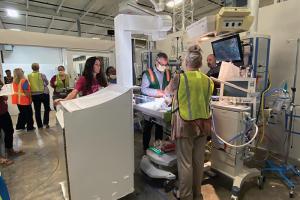Streamlining steps in outpatient facilities
Also in this article: |
| Designing Lean ambulatory care facilities |
| Perfecting patient flow and experience |
| |
If it takes 30 seconds to escort a patient to an exam room and a staff member does this 20 times a day, five times a week, 52 weeks a year, streamlining even that small piece of workflow can mean a lot to an organization over the life of a building. David J. O’Brien, director of strategic planning, Anderson Brulé Architects Inc., San Jose, Calif., says, “Lean is about trying to take advantage of often-small improvements that can manifest into real savings because of the numbers involved.”
Relatively high patient volume and relatively short patient encounter times (especially compared with, say, cardiac surgery) make ambulatory care a prime candidate for Lean, says Jennifer Aliber, AIA, FACHA, LEED AP, principal, Shepley Bulfinch, Boston. “When you do it well, you can see significant impact,” she says.
According to Shepley Bulfinch, applying Lean principles to the design of an urgent care center in Danvers, Mass., for North Shore Physicians Group significantly reduced the length of visits for patients requiring orthopedic radiology studies, while significantly increasing the amount of value-added, or productive, time spent by patients and the staff members attending them during these visits.
Lauren Janney, EDAC, LEED AP, associate, Shepley Bulfinch, says that by studying the needs of different types of patients at a facility, project teams can identify the appropriate length for patient visits. “It’s not about reducing that time an infinite amount, but really understanding what the right time is for patients to be in the clinic. And what you find in that process is, there is a lot of waste during the patient visit,” she says.
According to Rachel DeGuzman, licensed architect and director of planning, design and construction for Stanford Health Care, Palo Alto, Calif., there’s a movement to get rid of inefficiencies in health care. “There are so many processes when you look at health care,” she says. “There are so many steps involved and every step has its own set of inefficiencies. So, if we can streamline that, it only makes it better. It’s an industrywide approach — everybody’s trying to go much leaner.”




